Therapies
Welcome to our Therapies page. Here you will find information on the additional Therapies we offer as well as Osteopathy.
Osteopathy
Osteopathy is the recognised and established science of human mechanics; a system of diagnosis and treatment which lays the main emphasis on the structural and mechanical problems of the body.
Our Osteopaths are highly skilled in their sense of touch (palpation) and they use these skills to observe imbalances and dysfunction in the joints and soft tissue structures of the musculo-skeletal system (muscles, ligaments, capsules, fascia and tendons). Once the inter-relationship of these neighbouring structures is understood, they use a range of highly skilled techniques to treat the patient.
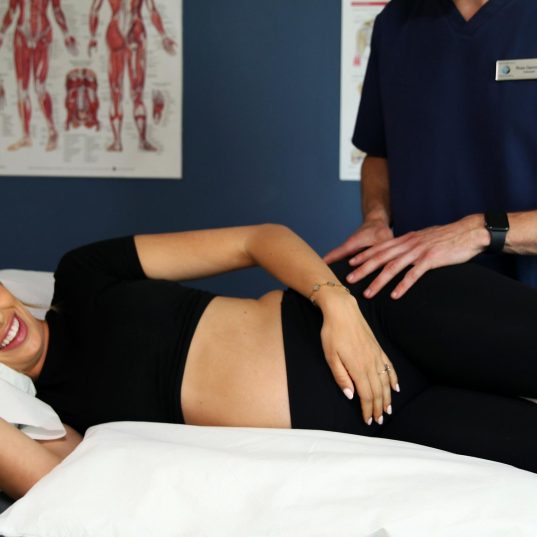
Treatments vary from patient to patient but may include :
- Soft tissue massage
- Joint articulation with varying degrees of subtlety
- Rhythmic stretching
- Joint manipulation
- High-Velocity-Thrust manipulation (HVT)
- Muscle Energy Technique (MET)
- Exercise prescription
Osteopaths are best known for the treatment in the following areas:
- Back Ache/Pain
- Sciatica
- Arthritic Pain
- Sports Injuries
- Muscle Spasm
- Muscle tension and inability to relax
- Joint Pain
- Shoulder Pain
- Headaches arising from the neck (cervicogenic)
- Migraine prevention
- Hip and Knee Pain from Osteoarthritis
- Elbow Pain
- Tennis/Golfer's Elbow
- Frozen Shoulder
- Generalised Aches and Pains
- Lumbago
- Neuralgia
- Fibromyalgia
- Digestive problems
- Circulatory problems
- Rheumatic Pain
- Cramp
- To Aid Relaxation
For more information, visit our Osteopathy page here.
“Thank you for help managing my back problems with clear explanations, good advice and healing treatment, all provided in such a friendly, welcoming setting. I’m delighted to recommend you to my friends and neighbours”
Mrs S Reed, Northallerton
Cranial Osteopathy
Cranial osteopathy is not different to osteopathy, it is the name given to a subtle and refined approach to osteopathy that follows all the principles of osteopathy, but that includes the anatomy and physiology of the head.
Cranial osteopaths use a highly trained sense of touch to feel subtle changes of tension and tissue quality in the living anatomy of the whole body, and to diagnose areas of strain or dysfunction.
Through palpation, the osteopath is often drawn to areas in the body that have been affected by past events, such as old accidents and injuries. The body may have learned to compensate for a traumatic event or injury and the patient may be unaware that there is anything wrong, but the effects may still be present and relevant to current symptoms.
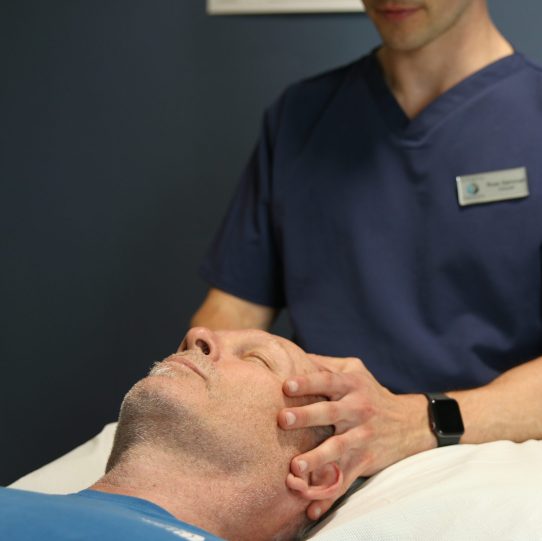
Joanna is a Fellow of the Sutherland Cranial College of Osteopathy (SCCO), having completed nine modules of the post-graduate cranial osteopathic pathway. She also teaches on the SCCO Paediatric Osteopathy Diploma. She was awarded the Diploma in 2016.
What patients and conditions can cranial osteopathy help?
This approach to osteopathy is a way of viewing the body rather than a type of technique and it can be used on every patient – we treat people not conditions. Cranial osteopathy is widely known for the treatment of babies but is equally effective for children, adults and the elderly. In any osteopathic treatment, the whole body is involved and improvements are often noted in different areas and different systems than just the symptomatic one.
For more information, please visit the SCCO website where there is lots of information about the history and philosophy of cranial osteopathy.
“I am very pleased with the treatment I receive, and the staff are very helpful and professional. I highly recommend them”
Mrs A Howe, Thirsk
Paediatric Osteopathy
Our osteopaths treat babies, children and teenagers. Osteopaths are statutorily regulated primary healthcare professionals, who work in private practice and in NHS settings. All osteopaths are qualified to treat babies and children and many osteopaths hold specialist post-graduate qualifications in paediatric osteopathy, such as those offered by the SCCO.
Our osteopath and clinical director Joanna Waterworth has a special interest in Paediatric Osteopathy.
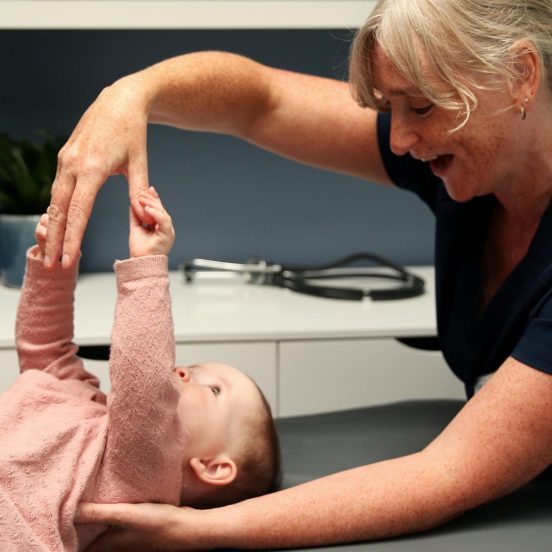
and in 2010, completed the pathway to become a fellow of the college (FSCCO), one of a handful of osteopaths in the North East to hold this qualification. Recently, she was invited onto the faculty for the Sutherland Cranial College of Osteopathy to develop and deliver their post-graduate Paediatric Osteopathy Diploma. She was awarded the Diploma in 2016.
For more information, please visit the SCCO website where there is lots of information about the history and philosophy of cranial osteopathy and the treatment of babies and young children.
“A huge thank you for helping us after months of torture! Freddie is now 10 months old and a little belter! No more straining, no more Movicol, no more sleepless nights!! He has weaned beautifully and is a very happy and content little boy… thanks to you! We are forever grateful for giving us a sense of ‘normality’ and a very lively little fella! Keep up the good work Jo”
Leanne & Freddie, Northallerton
Sports Therapy
Sports therapy is a health care discipline dedicated to preventing, treating, and rehabilitating injuries associated with sports and physical activity.
Sports Therapists work in diverse settings, including sports clubs, clinics, and private practices, and collaborate with other healthcare professionals to deliver comprehensive care. Both of our Sports Therapists have completed a 3-year degree in Sports Therapy.
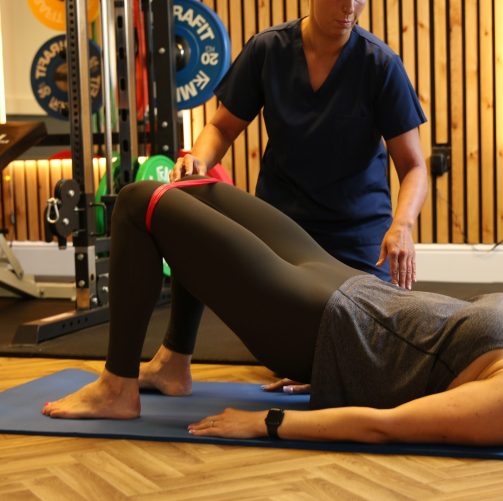
Sports therapists assist athletes and active individuals of all abilities in achieving peak performance and recovering from injuries. Key components of sports therapy in the UK include:
Injury Prevention
Developing programs and offering advice to help prevent injuries through conditioning, strength training, and flexibility exercises.
Assessment and Diagnosis
Using various techniques, including physical examinations and movement assessments, to evaluate and diagnose sports-related injuries.
Treatment
Employing methods such as manual therapy, massage, taping, and electrotherapy to relieve pain and promote healing.
Rehabilitation
Creating and implementing rehabilitation programs to ensure safe and effective recovery, focusing on restoring strength, flexibility, and function.
Performance Enhancement
Providing advice and training programs to enhance athletic performance by improving technique, strength, and endurance.
Education and Advice
Offering guidance on injury prevention, proper training techniques, and overall health and wellness.
January Sports Therapy Offer
BUY 3 GET 1 FREE
Train Smart This January
Pay for 3 Sports Therapy appointments up front, get 1 free.
Appointments must be paid for in full by 31st January.
All 4 appointments must be used by 31st March.
Your free session can be a choice of Sports Therapy, Sports Massage, Cupping, VALD strength & ROM assessment, Pre & Post surgery rehabilitation.
Appointments can be with Jade, Eli or a mixture between the two practitioners.
Offer available only to New Patients or Patients who have not had a Sports Therapy appointment for 6 months.
Massage Therapy / Sports Massage
Massage has been used for centuries as a way of aiding relaxation, helping with sleep, as well as relieving anxiety and stress. It is usually a safe therapy for all age groups.
Sports Massages can be booked with either of our Sports Therapists Jade & Eliana
Remedial Massages can be booked with our Massage Therapist Helen.
Relaxation Massage
This helps to promote deep relaxation and a sense of calm and relieves anxiety and stress.
Massage signals the brain to release ‘endorphins’ – the chemicals which give us the feelings of wellbeing and are also our natural painkillers. Endorphins reduce the amount of stress hormones (adrenalin and cortisol) that we make – high levels of these hormones have been shown to slow healing and impair the immune system.
Lymphatic drainage techniques are particularly helpful for releasing tension.
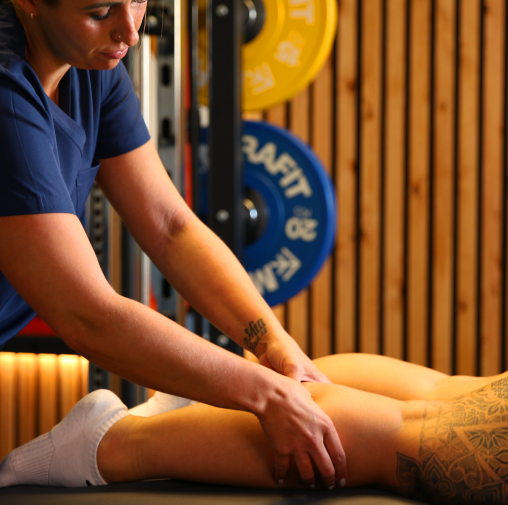
Therapeutic/ Remedial Massage
This style of massage involves working with tissues on a variety of levels and is often used after injury or strain, but can also be used on a regular basis to “maintain” well being. Remedial massage may reduce stress induced muscle tensions.
During treatment we may work on specific ‘trigger points’ where an area of contracted muscle refers pain to a distant area.
This style of massage is an excellent way of helping to ease musculoskeletal problems.
Sports Massage/ Deep Tissue
These types of massage may benefit people participating in sports and regular exercise and those working in demanding physical jobs.
Treatments vary from back and shoulder work, to deep tissue and muscle work of the legs for runners or people playing sport regularly.
These massages may aid the bodies own natural lymph circulation which eliminates toxins and transports nutrients to the cells.
Back, Neck & Shoulder Treatments
Various levels of pain and sometimes loss of mobility can be caused by problems arising from the head, neck and shoulder areas.
Problems may be caused by stress, injury, posture and other lifestyle factors.
Many of our pains and strains are caused by routine activities such as desk and computer based work, repetitive strains from driving, or even awkward sleeping positions.
As a lot of tension is carried in the neck, shoulders and chest, this massage focuses on opening up the chest, relaxing the shoulders and relieving tensions in the back. This treatment combines a number of stretching and passive movements, guiding the joints gently.
Acupuncture
An ancient medical system based on Traditional Chinese Medicine in which fine, disposable needles are inserted at specific points in the body for therapeutic or preventative purposes. In Western society acupuncture is a commonly used complementary medicine used to treat a number of conditions.
Our Acupuncturists treat the patients as a whole and not just the issue they’ve arrived with. The evidence base for acupuncture is increasing and here in the UK, NICE recommends acupuncture for specific health related issues.
Below are some of the conditions that acupuncture can help treat at Northallerton Osteopaths.
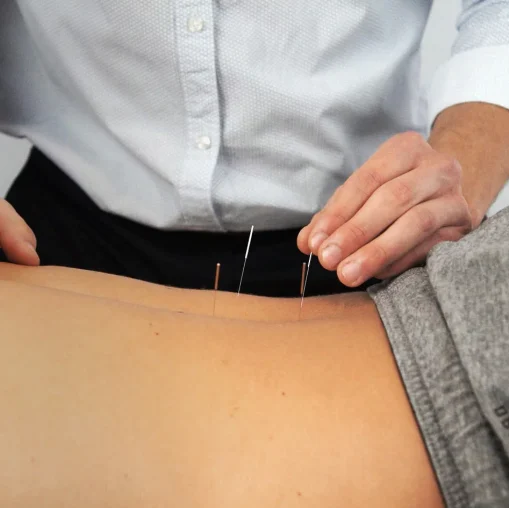
Conditions Treated
- Migraine
- Headache
- Back pain
- Shoulder and neck pain
- Muscle pain
- Frozen Shoulder
- Sports Injuries
- Fertility
- Depression
- Anxiety
- Insomnia
- Irritable Bowel Syndrome (IBS)
- Cancer Care
- Chronic Rhinitis (hay fever)
For more information on Acupuncture see the website of our Acupuncturist Stacey.
Check out Stacey's blog post on Acupuncture and Migraines.
“I recently had acupuncture on my back due to having back ache, throughout the entire treatment they remained professional and advised me how the treatment would go from start to finish as this was the first time I had this done. I work in an office and regularly get back aches and pains from work but with receiving this treatment it has massively eased off and my back feels more relaxed I can't recommend this treatment and acupuncturists highly enough”
Kirstie Lambert
Podiatry
What is a podiatrist?
A Biomechanical Podiatrist is a clinician that specialises in problems of the lower limb and feet that can affect your lower limb, back and gait.
A biomechanical podiatrist uses off the shelf Orthoses, made to measure Orthoses, pressure deflective insoles, heels raises and shoe modifications.
A new patient appointment lasts on average one hour and a follow up appointment 30 minutes.
How can it help me?
Problems that a biomechanical podiatrist can treat include:
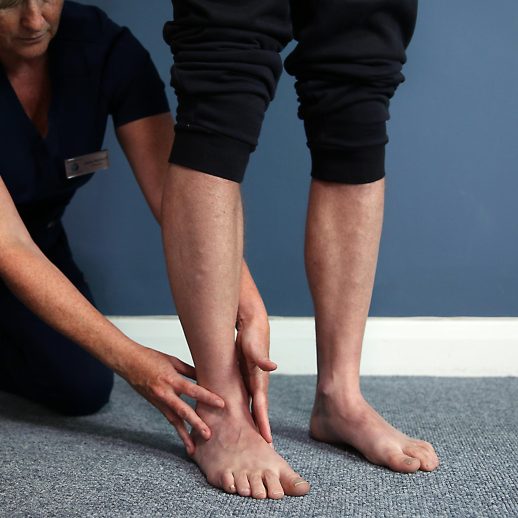
- Heel pain, including calcaneal spurs and plantarfasciitis
- Burning/numbness of toes including plantar interdigital neuromas
- Pain under the ball of the foot including sub metatarsal and intermetatarsal bursitis
- Hallux valgus/Bunions
- Clawed toes
- Knee pain
- Shin splints
- Ankle pain and sprains
- Hip pain
- Lower back pain
- Leg length discrepancies
A biomechanical podiatrist can also help improve your running style, improve your running times, and improve/alter your gait.
Reflexology
Your feet are like a mirror of your body…they can paint a picture of your health over the last 6-12 months.
There are over 7000 nerve endings in your feet and by treating the reflexes they send nerve signals and stimulate the central nervous system in quite a precise way, which will re-balance your body systems and aid in improving and managing your physical and psychological health.
Up to 75% of illnesses are thought to be stress-related in some form. The aim of reflexology is to encourage your body to heal itself and relieve stress and tension in a totally non-intrusive way, just purely by generating a very deep relaxation within you, which will bring your whole body into total alignment.
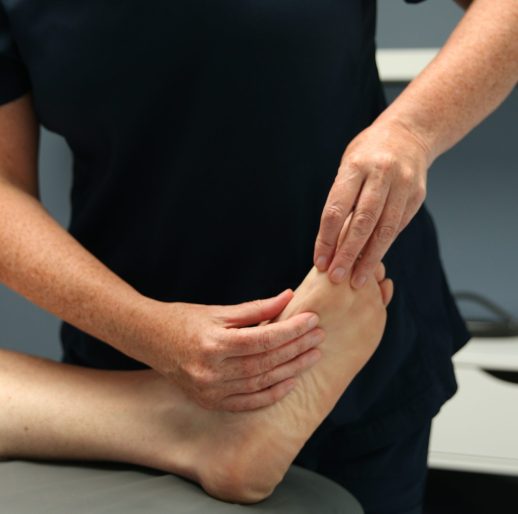
Some of the key benefits of reflexology are improved blood circulation, respiratory function, endocrine (hormone) flow, immune activity, pain relief, digestive movement, fatigue, muscle tension, as well as reducing stress and anxiety. It helps detoxify your body by flushing toxins and waste out and thus facilitating better transportation of nutrients, basically it aids the body get to a state of homeostasis (stability), which is the key to life at the end of the day.
The result is a natural balance and you will feel an immense sense of tranquility, calmness and well-being if you make reflexology part of your life. A soothing foot bath prior to your treatment and a relaxing foot massage during and afterwards will enhance your wonderful experience.
Clinical Hypnotherapy
What is Hypnosis?
Simply put, it is an altered state of consciousness. We all go in and out of trance states on a daily basis, for example, day dreaming or driving your car from A to B without remembering exactly how you got there. Even though Hypnotherapy involves the induction of a trance like state, you are not asleep. On the contrary, you are fully in control, and although deeply relaxed, have an enhanced state of awareness. Under hypnosis, you experience a sense of deep relaxation, and your attention is focused on the suggestions made by the therapist. The therapist bypasses your conscious mind and speaks directly to your subconscious mind, making suggestions that will bring about the desired lifestyle changes, firmly planting the seeds of change in your subconscious mind.
What happens during a treatment?
Initially you will be invited to consult with a hypnotherapist so that a full assessment of your problem can be made. This allows you to plan and agree an effective programme of treatment.
If hypnosis is agreed as a way forward, you may then be invited to experience hypnosis by being guided towards a state of deep relaxation, which most people find very pleasant. A full treatment will be made to affect the desired positive changes.
Can I be hypnotised?
Yes, everyone has the ability to enter a hypnotic state, but you must want to be hypnotised. The hypnotherapist does not take over control of your mind and cannot make you do anything that you do not want to. Hypnosis is simply a way of communication with your subconscious mind in order to make changes that are good for you. If you do want to be hypnotised, then hypnosis can work very effectively for you.
What can be helped with Hypnotherapy?
Hypnotherapy is a very powerful tool in contributing towards the successful treatment of a range of conditions including:
- Stress, anxiety and panic attacks
- Sleep problems
- Chronic fatigue and chronic illness
- Problems with confidence, self-esteem and assertiveness
- Body image problems
- Nausea
- Weight loss
- Stop smoking
- Phobias
- Pain control
- Tinnitus
"Through a very dark and confused period of my life, Fiona's understanding and compassion became a safe refuge I could rely on. I will remain forever grateful for my time with Fiona"
Herbal Medicine
Herbal Medicine is one of the oldest systems of medicine, in fact the World Health Organisation estimates 85% of the World’s population is still dependant on the healing properties of plants for health and treating disease.
Herbalists treats each person as a unique individual and prescribes herbal medicines to obtain or regain optimum health. The condition treated may be of a short or long term nature.
Medical Herbalists are trained in similar diagnostics and clinical skills to orthodox doctors but they treat in a holistic way by seeking and identifying the underlying cause of the problem, not just the symptoms of the disease.
Herbal Medicine is provided by our Medical Herbalist Janice Miller on alternate Tuesdays.

Audiology
Ear Wax Removal & Hearing Assessments
Zanib Iqbal is our registered Clinical Senior Audiologist Zanib and offers a broad range of expertise within the field of Audiology.
Zanib's specialisms include:
- Ear Wax removal
- Hearing Assessments
- Hearing Aid Dispensing
- Tinnitus Management
- Paediatric Hearing Assessments
- Vestibular Testing
- Ear Pain
- Ear Itchiness/Dry Skin
- Falls
- Social Assessment

Ear Wax Removal
Earwax can build up in the ear canals for many reasons. Earwax build-up may mean earwax removal could be necessary if this build-up of wax becomes a problem.
For most people, their ears will get rid of the excess wax in natural ways by moving to the outer ear via jaw movements from eating or talking, after which, it would dry and flake off. However, sometimes earwax can block the ear canals and reduce hearing. Earwax blockages can arise by ear producing too much wax, using earplugs, using hearing aids or even hereditary issues.
Symptoms of ear wax build up
Some symptoms you may experience are:
- Earache
- Difficulty in hearing
- Itchiness
- Dizziness
- Ear infection
- Tinnitus, which can be sounds or high-pitched ringing coming from inside the ear
Contact our clinic on 01609 783 600 to book an assessment to see if micro-suction or other safe earwax removal solutions may benefit your hearing.
How can we help remove the wax?
If you feel like your hearing quality may be affected due to earwax building up in your ears, it is a good idea to seek advice from an audiologist. Our trained Senior Audiologist is Zanib Iqbal.
Zanib will tell you if your hearing is being affected by earwax build-up or other hearing loss causes where a different solution would be more beneficial.
Once the cause of your hearing problem is identified; Zanib would suggest the most appropriate course of action, in most cases, this is micro-suction.
Micro suction is the most innovative and safest way of earwax removal. It is a quick, easy and painless method, which makes it very popular. As well as the possibility of improving your hearing, micro Suction wax removal can sometimes also improve a tinnitus issue.
Wax removal using micro-suction
Micro-suction is the gold standard procedure, hence the safest way to remove excessive earwax, as stated by the National Institute for Health and Care Excellence. The procedure is suitable for most of the population and experiencing any side effects after the treatment is very rare. Micro-suction involves using a binaural microscope to examine the ear, which will safely aid the removal of wax. A gentle suction device removes the wax and debris.
A Video Otoscopy will be performed before the micro-suction procedure. This procedure will allow you to view the wax accumulation occurring inside your ear canal.
A fine suction probe is carefully inserted into the ear canal while being viewed closely under magnification from a microscope. Wax is removed from the ear by suction from the tube. This procedure can be quite noisy.
Some symptoms you may experience prior to the treatment are:
Earache, Difficulty in hearing, Itchiness, Dizziness, Ear infection, Tinnitus.
Our trained Audiologist Zanib has undertaken training in wax removal and will use best practice procedures to minimise any risk of harm. However, even when performed with the utmost care, there are risks involved in wax removal.
These risks include:
- Damage to skin of the ear canal or the eardrum during the procedure
- Infection of the ear canal or other ear structures following the procedure
- Temporary reduction in hearing
- Temporary dizziness and (rarely) possible sickness or fainting
- Triggering of new tinnitus or temporary aggravation of existing tinnitus
- Temporary irritation to the throat (especially if already dry, tickly, or sensitive)
If the wax cannot be removed
Sometimes, depending on the amount and consistency of the wax and your own comfort, it may not be possible to remove all the wax in one attempt. If this situation occurs Zanib will stop the procedure and you will be advised to continue to use Earol twice a day for 5 days and then return to have the remainder removed.
Hearing Assessments
As well as earwax removal, Zanib also offers Hearing Assessments & Hearing Aid Dispensing here at Northallerton Osteopaths. In some cases where earwax build-up may not be the cause for hearing impairment, Zanib can investigate the issue further to find the cause for an issue. If you are unsure what your needs may require, please feel free to contact our clinic to request a call back from Zanib who would be happy to discuss your issue in greater detail.
To book an appointment with Zanib Iqbal, please call our clinic on 01609 783 600 or Book Online.
Nutritional Therapy
What is Nutritional Therapy?
Nutritional therapy utilises nutrition and lifestyle medicine sciences to investigate potential imbalances in the body and how they may be contributing to an individual’s symptoms or health concerns. It is a highly personalised approach that takes account of each individual's unique biochemistry, their health journey and their lifestyle.
Our nutritional therapist trained using the Functional Medicine Model. Functional Medicine is detailed, holistic and client-centred; seeking to understand the root causes of health issues and assessing the person as a whole, rather than just treating the symptoms.
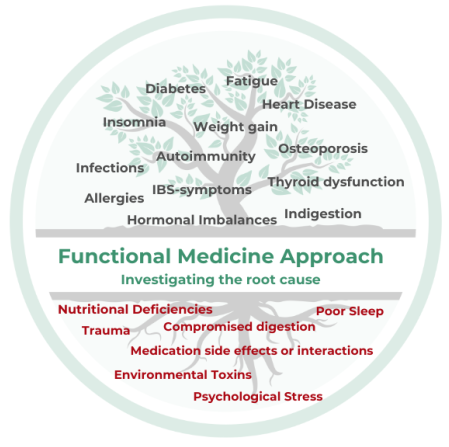
Body systems do not work independently but are all interconnected. During nutritional therapy all systems are assessed in order to investigate potential imbalances: immunity, digestion, detoxification, energy metabolism, endocrine (hormonal) and nervous system, structural (including musculoskeletal).
Assessment
The assessment also includes family and medical history, medications and supplements, environmental factors such as diet, chemical exposure and lifestyle factors such as sleep, movement and stress levels. Functional lab testing can be recommended if appropriate. Examples include blood and urine testing for nutritional deficiencies and hormonal imbalances, or stool testing for digestive function and microbiome assessment.
Appointments
Our Nutritional Therapist takes great care and invests time obtaining a comprehensive health history, with clients asked to answer a detailed questionnaire prior to their first appointment. This is followed by a 90 minute initial consultation and 45 minute follow-up appointments.
Implementing new nutrition and lifestyle practices takes time so clients are initially invited to book onto a program of either 3 or 6 sessions depending on the complexity of their case. This will be discussed and agreed during a free 20 minute discovery call with the nutritional therapist to ensure the client receives the correct support for their individual circumstances.
If lab testing is used during the program to investigate potential underlying imbalances the client’s bespoke protocol is adjusted to take account of any significant findings. After a program is completed clients can book onto individual sessions as and when they would like additional guidance and support.
Nutritional Therapy is provided by Lis Grey on Mondays. Find more about Lis on her website www.greywellness.co.uk
